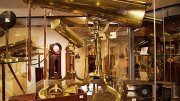At last, Harvard’s Collection of Historical Scientific Instruments has come up from its hiding place in the basement of the Science Center to reveal itself, radiantly, in the new Putnam Gallery on the main floor. That is, some 400 of its more than 20,000 objects have taken up permanent residence in the 2,000-square-foot gallery. Another 1,000 square feet of gallery space on the floor above houses temporary exhibitions staged by faculty members, students, and invited artists and researchers.
Harvard has acquired scientific instruments on a continuous basis for teaching and research since 1672. The elderly pieces of apparatus gathered here, made of brass, ebony, glass, wood, and ingenuity, have many individual tales to tell of jobs accomplished, the search for knowledge, and sometimes its discovery. In this photograph, the view is from a point near the back of the gallery, reflecting recent time, through years of people doing science to the Colonial era at front. Sara Schechner ’79, Ph.D. ’82, Wheatland curator of the collection, has clustered objects thematically. The prism-shaped case in the foreground concerns experiments on perception in Harvard’s psychological laboratory, founded by William James. Prominent is Edward Titchener’s color pyramid, circa 1924, a model of visual sensations defined by color, brightness, and saturation. Farther forward are some of the precision clocks that Harvard used when it was in the business of selling time. (Between 1831 and 1857 there were 97 train wrecks in New England, most blamed on timekeeping based on the sunand thus varying east to westby communities along the single-track lines. The College Observatory began to distribute standard time by wire to Boston and thence to other stations throughout the region. Trains collided less often. The system led to the establishment of the first time zone.)
The instrument collection, one of the greatest in the world, is unusual, says Schechner, because of the documentation in hand about the provenance and early uses of so many of its pieces of apparatus. Many were employed at Harvard, by graybeard faculty members or eager students, and the gallery features these, although not exclusively.
“The collection has become fully integrated into the research and teaching of the department of the history of science, offering support for work by undergraduates, graduate students, and faculty, as well as researchers from around the world,” writes Allan M. Brandtchair of that department, director of the collection, a professor of the history of science and, at the Medical School, a professor of the history of medicinein a pamphlet of essays given out at the gallery. He adds that the collection serves also “as a means of educating the general public about the important roles played by material culture in the making of modern scientific disciplines.” A broad range of those is represented, from astronomy, navigation, and surveying to geology, physics, medicine, mathematics, and communication.
The collection was established in 1949 by David P. Wheatland, later joined by Ebenezer Gay, to save the University’s significant scientific apparatus from being cannibalized for parts or discarded because no longer used. At first, physicist Wheatland kept the instruments in his office in Cruft Laboratory. The collection moved to the basement of the Semitic Museum, to the basement of Perkins Hall, to Allston Burr Lecture Hall, and, in 1980, to the Science Center underworld. Curator Schechner still forages, and snatched up the control panel of the Harvard cyclotron when that facility shut down in 2001. Today’s obsolete technology may be tomorrow’s museum piece.
The Putnam Gallery can be found near the east entrance of the Science Center, at 1 Oxford Street in Cambridge, and is open to the public, free of charge, from 11 a.m. to 4 p.m., Mondays through Thursdays.









